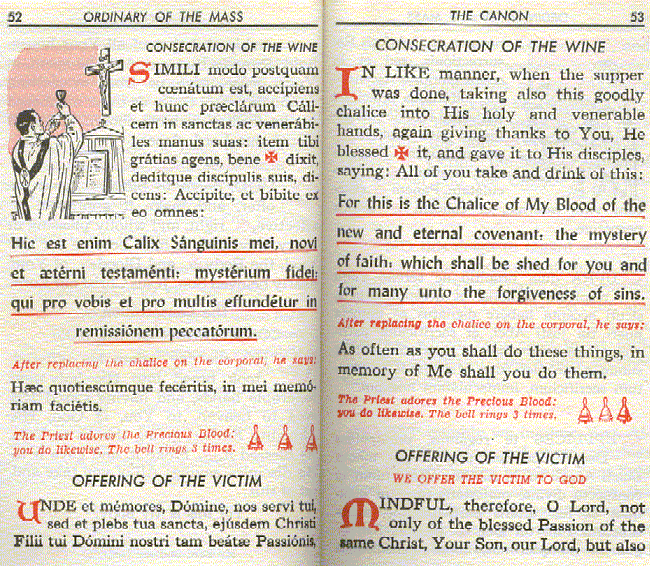
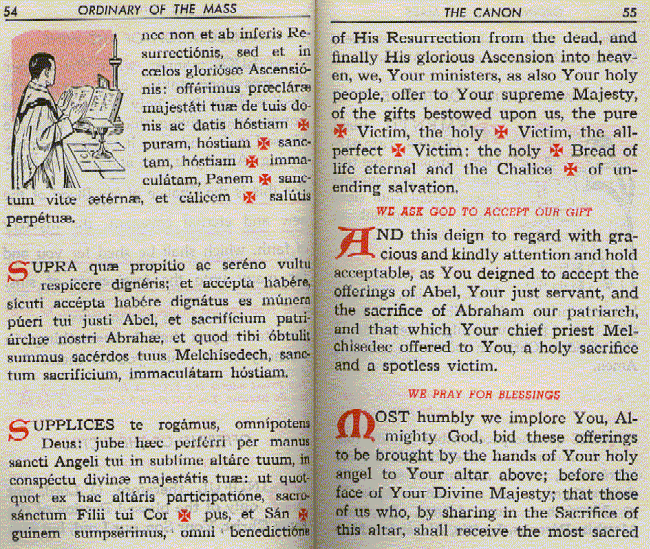
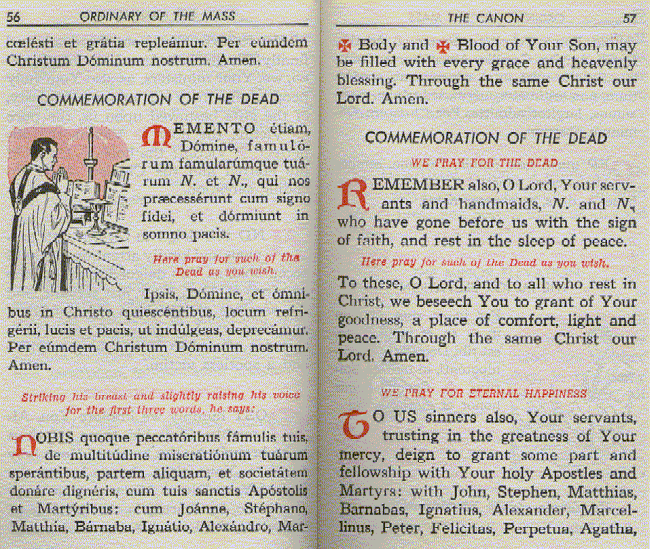
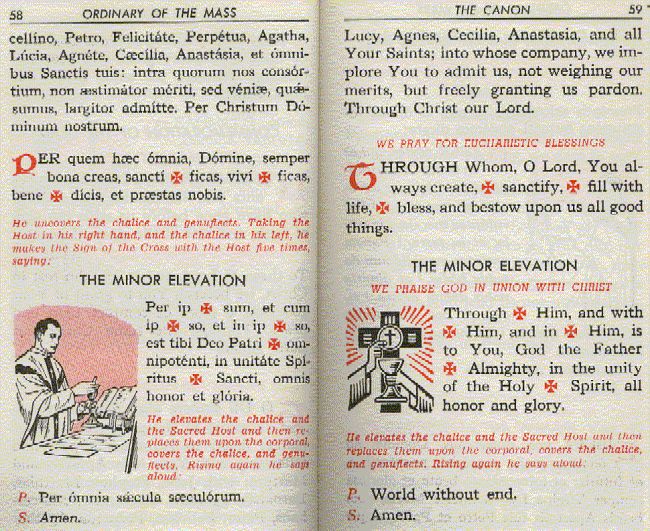
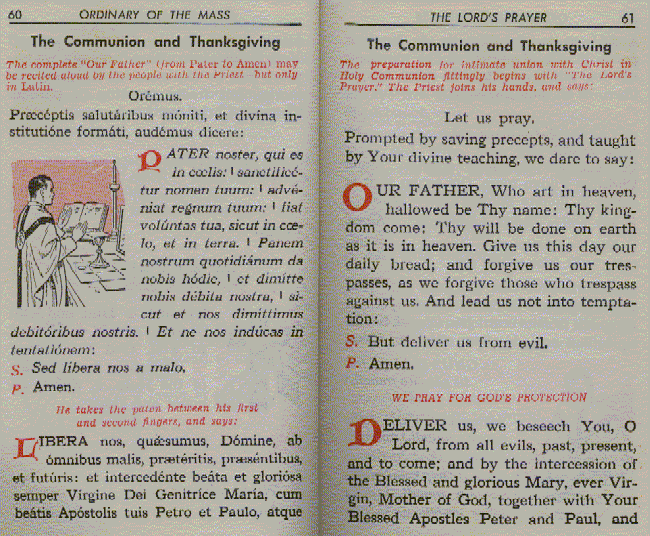
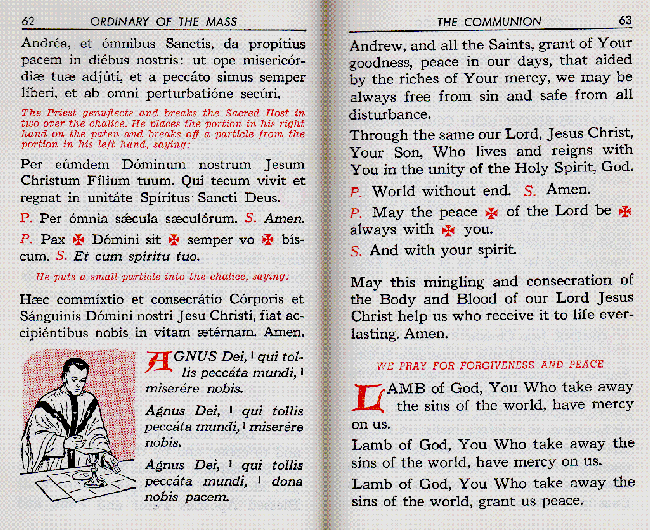
AGNUS DEI
Bowing down, the priest strikes his breast three times while saying the Agnus Dei:
P: Lamb of God, Who takest away the sins of the world: have mercy on us.
Lamb of God, Who takest away the sins of the world: have mercy on us.
Lamb of God, Who takest away the sins of the world: grant us peace.
P: O Lord Jesus Christ Who didst say to Thine apostles: Peace I leave you, My peace I give you: look not uon my sins, but upon the faith of Thy Church, and vouchsafe to grant her peace and unity according to Thy will: Who livest and reignest God, world without end. Amen.
The priest bows down to say the following two prayers of preparation for Communion:
P: O Lord Jesus Christ, Son of the living God, Who, according to the will of the Father, through the co-operation of the Holy Ghost, hast by Thy death given life to the world: deliver me by this Thy most Sacred Body and Blood from all my iniquities, and from every evil; make me always cleave to Thy commandments, and never suffer me to be separated from Thee, Who with the same God, the Father and the Holy Ghost, livest and reignest God, world without end. Amen.
P: Let not the partaking of Thy Body, O Lord Jesus Christ, which I, all unworthy, presume to receive, turn to my judgement and condemnation; but through Thy loving kindness may it be to me a safeguard and remedy for soul and body; Who, with God the Father, in the unity of the Holy Ghost, livest and reignest, God, world without end. Amen.
P: Agnus Dei, qui tollis peccata mundi, miserere nobis.
Agnus Dei, qui tollis peccata mundi, miserere nobis.
Agnus Dei, qui tollis peccata mundi, dona nobis pacem.
P: Domine Jesu Christe, qui dixisti Apostolis tuis: pacem relinquo vobis, pacem meam do vobis: ne respicias peccata mea, sed fidem Ecclesiae tuae; eamque secundum voluntatem tuam pacificare et coadunare digneris. Qui vivis et regnas Deus, per omnia saecula saeculorum. Amen.
P: Domine Jesu Christe, Fili Dei vivi, qui ex voluntate Patris cooperante Spritu Sancto, per mortem tuam mundum vivificasti: libera me per hoc sacrosanctum Corpus et Sanguinem tuum ab omnibus iniquitatibus meis et universis malis: et fac me tuis semper inhaerere mandatis: et a te nunquam separari permittas: qui cum eodem Deo Patre et Spiritu Sancto vivis et regnas Deus in saecula saeculorum. Amen.
P: Perceptio Corporis tui, Domine Jesu Christe, quod ego indignus sumere praesumo, non mihi proveniat in judicium et condemnationem: sed pro tua pietate prosit mihi ad tutamentum mentis et corporis, et ad medelam percipiendam. Qui vivis et regnas cum Deo Patre in unitate Spiritus Sancti Deus, per omnia saecula saeculorum. Amen.
THE COMMUNION
The priest genuflects, rises and says
P: I will take the bread of heaven, and will call upon the name of the Lord. Taking the Sacred Host with his left hand, the priest strikes his breast three times, saying (here the bell is rung each of the three times with the priest)
P: Lord, I am not worthy that Thou shouldst enter under my roof; but only say the word, and my soul shall be healed. (three times)
Holding the Sacred Host in his right hand, the priest makes the sign of the cross with it and says
P: May the Body of Our Lord Jesus Christ keep my soul unto life everlasting. Amen.
The priest receives Holy Communion and after a brief meditation continues
P: What shall I render unto the Lord for all the things that He hath rendered unto me? I will take the chalice of salvation and will call upon the name of the Lord. With high praises will I call upon the Lord, and I shall be saved from all mine enemies.
The priest takes the Chalice in his right hand and makes the sign of the cross, saying
P: May the Blood of Our Lord Jesus Christ keep my soul unto life everlasting. Amen.
Here the faithful come forward to receive Holy Communion at the Communion rail. [The server recites the Confiteor in the name of the communicants. The priest responds with the Misereatur and the Indulgentiam.] Then, the priest faces the people with the Ciborium and, holding up one of the Sacred Particles before the communicants, he says
P: Behold the Lamb of God, behold Him who taketh away the sins of the world.
P: Lord, I am not worthy that Thou shouldst enter under my roof; but only say the word, and my soul shall be healed. (three times)
P: Panem coelestem accipiam et nomen Domini invocabo.
P: Domine, non sum dignus ut intres sub tectum meum: sed tantum dic verbo, et sanabitur anima mea (three times).
P: Corpus Domini nostri Jesu Christi custodiat animam meam in vitam aeternam. Amen.
P: Quid retribuam Domino pro omnibus quae retribuit mihi? Calicem salutaris accipiam, et nomen Domini invocabo Dominum, et ab inimicis meis salvus ero.
P: Sanguis Domini nostri Jesu Christi custodiat animam meam in vitam aeternam. Amen.
P: Ecce Agnus Dei, ecce Qui tollit peccata mundi.
P: Domine, non sum dignus, ut intres sub tectum meum: sed tantum dic verbo, et sanabitur anima mea. (Three times)
COMMUNION OF THE FAITHFUL
The priest gives Holy Communion to each communicant saying
P: May the Body of Our Lord Jesus Christ keep your soul unto life everlasting. Amen.
When all have received Communion, he returns to the altar and replaces the Ciborium in the tabernacle. He then receives wine in the Chalice and says
P: Into a pure heart, O Lord, may we receive the heavenly food which has passed our lips; bestowed upon us in time, may it be the healing of our souls for eternity.
The priest goes to the Epistle side and, while the server pours wine and water over his fingers, he says
P: May Thy Body, O Lord, which I have received, and Thy Blood which I have drunk cleave to mine inmost parts: and do Thou grant that no stain of sin remain in me, whom pure and holy mysteries have refreshed: Who livest and reignest world without end. Amen.
P: Corpus Domini nostri Jesu Christi custodiat animam tuam in vitam aeternam. Amen.
P: Quod ore sumpsimus Domine, pura mente capiamus: et de munere temporali fiat nobis remedium sempiternum. P: Corpus tuum, Domine, quod sumpsi, et Sanguis, quem potavi, adhaereat visceribus meis: et praesta, ut in me non remaneat scelerum macula, quem pura et sancta refecerunt sacramenta. Qui vivis et regnas in saecula saeculorum. Amen.
COMMUNION ANTIPHON
P: The Lord be with you.
R: And with thy spirit.
P: Let us pray.
The priest recites the Communion verse for the Mass being celebrated at the Epistle side.
P: Dominus vobiscum.
R: Et cum spiritu tuo.
P: Oremus.
THE POSTCOMMUNION
The priest at the Epistle side recites the Postcommunion for the Mass being celebrated. Then he returns to the middle, kisses the altar, and turning toward the people says
P: The Lord be with you.
R: And with thy spirit.
P: Go, the mass is ended.
R: Thanks be to God.
Bowing down over the altar, the priest says
P: May the lowly homage of my service be pleasing to Thee, O most holy Trinity: and do Thou grant that the sacrifice which I, all unworthy, have offered up in the sight of Thy majesty, may be acceptable to Thee, and, because of Thy loving kindness, may avail to atone to Thee for myself and for all those for whom I have offered it up. Through Christ our Lord. Amen. P: Dominus vobiscum.
R: Et cum spiritu tuo.
P: Ite, missa est.
R: Deo gratias.
P: Placeat tibi sancta Trinitas, obsequium servitutis meae; et praesta, ut sacrificium, quod oculis tuae majestatis indignus obtuli, tibi sit acceptabile, mihique et omnibus, pro quibus illud obtuli, sit, te miserante, propitiabile. Per Christum Dominum nostrum. Amen.
THE BLESSING
The priest kisses the altar, and at the word "Pater," turns toward the people, blesses them, saying
P: May almighty God, the Father, and the Son + , and the Holy Ghost, bless you. R: Amen.
P: Benedicat vos omnipotens Deus, Pater, et Filius + , et Spiritus Sanctus. R: Amen.
THE LAST GOSPEL
The priest now goes to the Gospel side of the altar; he makes the sign of the cross, first upon the altar, and then upon his forehead, lips, and heart, and reads the Last Gospel
P: Dominus vobiscum.
R: Et cum spiritu tue.
P: Initium sancti Evangelii secundum Joannem.
R: Gloria tibi Domine.
P: In prinicipio erat Verbum, et Verbum erat apud Deum, et Deus erat Verbum. Hoc erat in principio apud Deum. Omnia per ipsum facta sunt, et sine ipso factum est nihil quod factum est. In ipso vita erat, et vita erat lux hominum: et lux in tenebris lucet, et tenebrae eam non comprehenderunt. Fuit homo missus a Deo, cui nomen erat Joannes. Hic venit in testimonium, ut testimonium perhiberet de lumine, ut omnes crederent per illum. Non erat ille lux, sed ut testimonium perhiberet de lumine. Erat lux vera quae illuminat omnem hominem venientem in hunc mundum. In mundo erat, et mundus per ipsum factus est, et mundus eum non cognovit. In propria venit, et sui eum non receperunt. Quotquot autem receperunt eum, dedit eis potestatem filios Dei fieri, his qui credunt in nomine ejus. Qui non ex sanguinibus, neque ex voluntate carnis, neque ex voluntate viri, sed ex Deo nati sunt. (Here all genuflect) ET VERBUM CARO FACTUM EST, et habitavit in nobis et vidimus gloriam ejus, gloriam quasi unigeniti a Patre, plenum gratiae et veritatis.
R: Deo gratias.
P: The Lord be with you.
R: And with thy spirit.
P: The beginning of the holy Gospel, according to St. John.
R: Glory be to Thee, O Lord.
P: In the beginning was the Word, and the Word was with God, and the Word was God. The same was in the beginning with God. All things were made by Him, and without Him was made nothing that was made. In Him was life, and the life was the light of men: and the light shineth in darkness, and the darkness did not comprehend it. There was a man sent from God, whose name was John. This man came for a witness to give testimony of the light, that all men might believe through him. He was not the light, but was to give testimony of the light. That was the true light which enlighteneth every man that cometh into this world. He was in the world, and the world was made by Him, and the world knew Him not. He came unto His own, and His own received Him not. But as many as received Him, to them He gave great power to become the sons of God: to them that believe in His name: who are born, not of blood, nor of the will of the flesh, nor of the will of man, but of God. And the Word was made flesh, and dwelt among us, and we saw His glory, the glory as of the only begotten of the Father, full of grace and truth.
R: Thanks be to God.
PRAYERS AFTER LOW MASS
After Low Mass, the priest kneeling at the altar steps, says with the people the prayers which follow:
Hail Mary, full of grace, the Lord is with thee. Blessed art thou amongst women, and blessed is the fruit of thy womb, Jesus. Holy Mary, Mother of God, pray for us sinners, now, and at the hour of our death. Amen. three times)
HAIL HOLY QUEEN
Hail, holy Queen, Mother of mercy, our life, our sweetness, and our hope! To thee do we cry, poor banished children of Eve, to thee do we send up our sighs, mourning and weeping in this valley of tears. Turn then, most gracious Advocate, thine eyes of mercy towards us, and after this our exile show unto us the blessed fruit of thy womb, Jesus. O clement, O loving, O sweet virgin Mary.
P: Pray for us, O holy Mother of God.
R: That we be made worthy of the promises of Christ.
P: Let us pray. O God, our refuge and our strength, look down with favor upon Thy people who cry to Thee; and through the intercession of the glorious and immaculate Virgin Mary, Mother of God, of her spouse, blessed Joseph, of Thy holy apostles, Peter and Paul, and all the saints, mercifully and graciously hear the prayers which we pour forth to Thee for the conversion of sinners and for the liberty and exaltation of holy mother Church. Through the same Christ our Lord. Amen.
St. Michael, the archangel, defend us in battle. Be our protection against the malice and snares of the devil. We humbly beseech God to command him. And do thou, O prince of the heavenly host, by the divine power thrust into hell Satan and the other evil spirits who roam through the world seeking the ruin of souls. Amen.
INVOCATION AFTER MASS
P: Most Sacred Heart of Jesus.
R: Have mercy on us! (three times)
Ave Maria, gratia plena, Dominus tecum. Benedicta tu in mulieribus, et benedictus fructus ventris tui, Jesus.
Sancta Maria, Mater Dei, ora pro nobis peccatoribus, nunc, et in hora mortis nostrae. Amen. (three times)
SALVE REGINA
Salve Regina, Mater misericordiae. Vita, dulcedo, et spes nostra, salve. Ad te clamamus exsules filii Hevae. Ad te Suspiramus, gementes et flentes in hac lacrimarum valle. Eja ergo, Advocata nostra, illos tuos misericordes oculos ad nos converte. Et Jesum, benedictum fructum ventris tui, nobis post hoc exsilium ostende. O clemens, o pia, o dulcis Virgo Maria.
P: Ora pro nobis, sancta Dei Genitrix.
R: Ut digni efficiamur promissionibus Christi.
P: Oremus. Deus refugium nostrum et virtus, populum ad te clamantem propitius respice; et intercedente gloriosa et immaculata Virgine Dei Genitrice Maria, cum beato Josepho ejus Sponso, ac beatis Apostolis tuis Petro et Paulo, et omnibus Sanctis, quas pro conversione peccatorum, pro libertate et exaltatione sanctae Matris Ecclesiae, preces effundimus, misericors et benignus exaudi. Per eumdem Christum Dominum nostrum. Amen.
Sancte Michael Archangele, defende nos in praelio. Contra nequitiam et insidias diaboli esto praesidium. Imperet illi Deus, supplices deprecamur. Tuque princeps militiae caelestis, Satanam aliosque spiritus malignos, qui ad perditionem animarum pervagantur in mundo divina virtute in infernum detrude. Amen.
P: Cor Jesu sacratissimum,
R: Miserere nobis. (three times)
Is The New Mass Valid?
On April 3, 1969, Paul VI issued his constitution entitled Missale Romanum which marked the publication of the New Order of Mass (the Novus Ordo). Much has been said and discussed about the New Mass since its implementation approximately 30 years ago. Many people in various languages have pointed out the glaring doctrinal problems with the New Mass, and its startling differences from the Roman Rite - the Latin Tridentine Mass. Some of these discussions have focused on the legality of implementing a New Mass, while other authors have delved into the question of validity. We will focus very briefly on validity in this sheet.
1. Matter, Form, Minister and Intention.
A sacrament is valid if it takes place. The Sacrament of the Eucharist is valid if the bread and wine become the actual Body, Blood, Soul and Divinity of Jesus Christ. A sacrament is licit if it takes place lawfully. For example, the Eastern Schismatics celebrate Mass validly but illicitly, since they are not Roman Catholics. For a sacrament to be valid certain things are required.
Pope Eugene IV, Council of Florence, Session 8, Nov. 22, 1439, "Exultate Deo": "All these sacraments are made up of three elements: namely, things as the matter, words as the form, and the person of the minister who confers the sacrament with the intention of doing what the Church does. If any of these is lacking, the sacrament is not effected." (Decrees of the Ecumenical Councils, Georgetown Univ. Press, Vol. 1, p. 542; Denzinger, The Sources of Catholic Dogma, no. 695)
As we can see, for a sacrament to be valid you need matter, form, minister and intention. The matter are the "things" which are necessary to confect the sacrament. For example, in the Sacrament of Baptism, the matter is real and natural water. The form are the "words" which are necessary to confect the sacrament. In Baptism, the form is "I baptize thee in the name of the Father and of the Son and of the Holy Ghost," or words which mean precisely the same thing, such as: "Such a one is baptized by my hands in the name of the Father and of the Son and of the Holy Ghost." The minister of most sacraments is a validly ordained priest. However, in a state of necessity, anyone can act as a minister of baptism; and in marriage, the parties administer the sacrament to one another with the priest acting as an official witness. The intention necessary to confect a sacrament is the intention "to do what the Church does."
2. The Form of the Sacrament of the Eucharist.
The form of words necessary to confect the Sacrament of the Eucharist in the Roman Rite, that is, the words of consecration, have always been the same.
Pope Eugene IV, Council of Florence, Session 11, Feb. 4, 1442, "Cantate Domino":
"However, since no explanation was given in the aforesaid decree of the Armenians in respect to THE FORM OF WORDS which the holy Roman Church, relying on the teaching and authority of the apostles Peter and Paul, has always been wont to use in the consecration of the Lord's Body and Blood, we concluded that it should be inserted in this present text. It uses this form of words in the consecration of the Lord's Body: FOR THIS IS MY BODY. And of His blood: FOR THIS IS THE CHALICE OF MY BLOOD, OF THE NEW AND ETERNAL TESTAMENT: THE MYSTERY OF FAITH, WHICH SHALL BE SHED FOR YOU AND FOR MANY UNTO THE REMISSION OF SINS."(Decrees of the Ecumenical Councils, Vol. 1, p. 581)
Therefore, in the original Latin, the words of consecration, which are the form of the Sacrament of the Eucharist, are these:
Hoc est enim Corpus meum. Hic est enim Calix Sanguinis mei, novi et aeterni testamenti: mysterium fidei, qui pro vobis et pro multis effundetur in remissionem peccatorum.
A correct English translation of these words is, once again: For this is my Body. For this is the Chalice of my Blood, of the new and eternal testament: the mystery of faith, which shall be shed for you and for many unto the remission of sins.
Long before the dogmatic definition of the Council of Florence, St. Thomas Aquinas taught the same in his Summa Theologica. The following quote is one example of St. Thomas' clear belief that the form of the consecration of the Precious Blood includes all of the words cited above. The reader will notice that the following citation makes no mention of the words "This is My Body," for here St. Thomas is dealing specifically with the words which are needed in the consecration of the Precious Blood.
St. Thomas Aquinas, Summa Theologica, Pt. III, Q. 78, A. 3: "I answer that, there is a twofold opinion regarding this form. Some have maintained that the words 'This is the chalice of My blood belong to the substance of the form, but not those words which follow. NOW THIS SEEMS INCORRECT, because the words which follow them are determinations of the predicate, that is, of Christ's blood: consequently they belong to the integrity of its (i.e., the form's) recitation."
One could also cite St. Thomas in Scriptum Super Lib. IV Sententiarum (dist. 8, Q. 2, a. 2, p. 1, ad 3) and I Cor. XI, lect. 6, where he teaches that all the words cited above constitute the form of consecration; however the quote from the Summa Theologica should suffice. Now, we will quote Pope St. Pius V in the De Defectibus section of the Roman Missal, promulgated on July 19, 1570, in the famous bull Quo Primum.
Pope St. Pius V, De Defectibus, chapter 5, Part 1: "The words of Consecration, which are the FORM of this Sacrament, are these: FOR THIS IS MY BODY. And: FOR THIS IS THE CHALICE OF MY BLOOD, OF THE NEW AND ETERNAL TESTAMENT: THE MYSTERY OF FAITH, WHICH SHALL BE SHED FOR YOU AND FOR MANY UNTO THE REMISSION OF SINS. Now if one were to remove, or change anything in the FORM of the consecration of the Body and Blood, and in that very change of words the [new] wording would fail to mean the same thing, he would not consecrate the sacrament."
This authoritative teaching of the Roman Missal on the form of the Sacrament of the Eucharist is right in line with the teaching of the dogmatic Council of Florence. Furthermore, Pope St. Pius V in De Defectibus explains in the most clear terms how any change or removal of the words of consecration would render the Sacrament invalid, if the meaning were not preserved. This teaching appeared in the front of every Roman Altar Missal from 1570 to 1962, spanning the Pontificates of some 36 Popes who gave either their silent or explicit approval to this document. This is why all of these words are bolded in all Traditional Roman Altar Missals, and why the Roman Missal instructs priests to hold the Chalice until the completion of all of these words.
Further, as said already, without "the intention to do what the Church does," it is impossible to effect a sacrament (Pope Eugene IV, Council of Florence). In his dogmatic Bull, Apostolicae curae, Sept. 13, 1896, Pope Leo XIII teaches that a minister who uses the proper matter and form in effecting a sacrament "is presumed for that very reason to have intended to do what the Church does." On the other hand, a minister who does not use the correct matter or form is not presumed to have intended to do what the Church does, but rather to have a defective intention. This defective intention, which is present in a priest who does not use the correct form of consecration, would exist at the moment when he says, "This is My Body," and therefore he could not consecrate the Lord's Body.
3. The New Mass has a defective Form.
In Paul VI's New Mass, the Traditional Form of consecration as defined by Pope Eugene IV and Pope St. Pius V has been drastically altered. In almost all vernacular translations around the globe, including all of the New Masses in English, the form winds up reading like this:
For this is my body. For this is the chalice of my blood, of the new and eternal testament: the mystery of faith which shall be shed for you and for many unto the remission of sins FOR ALL SO THAT SINS MAY BE FORGIVEN.
Here we can identify an incredible change in the form of consecration. Without explanation, the New Mass has changed the word "many" to the word "all." (The New Mass has also removed the words “the mystery of faith” from the Consecration.) For an analysis of how changing the word “many” to “all” in the Consecration alters the meaning of the sacrament, we turn to St. Alphonsus De Liguori, a Doctor of the Church, and The Catechism of the Council of Trent, published by order of the Council of Trent.
St. Alphonsus De Liguori, Treatise on the Holy Eucharist: "The words pro vobis et pro multis (for you and for many) are used to distinguish the virtue of the Blood of Christ from its fruits: for the Blood of Our Savior is of sufficient value to save all men but its fruits are applied only to a certain number and not to all, and this is their own fault... This is the explanation of St. Thomas, as quoted by [Pope] Benedict XIV." (St. Alphonsus De Liguori, Treatise on The Holy Eucharist, Redemptorist Fathers, 1934, p. 44)
The Catechism of the Council of Trent, On the Form of the Eucharist: "The additional words for you and for many, are taken, some from Matthew, some from Luke, but were joined together by the Catholic Church under the guidance of the Spirit of God. They serve to declare the fruit and advantage of His Passion. For if we look to its value, we must confess that the Redeemer shed His Blood for the salvation of all; but if we look to the fruit which mankind have received from it, we shall easily find that it pertains not unto all, but to many of the human race. When therefore (our Lord) said: For you, He meant either those who were present, or those chosen from among the Jewish people, such as were, with the exception of Judas, the disciples with whom He was speaking. When He added, And for many, He wished to be understood to mean the remainder of the elect from among the Jews and Gentiles. WITH REASON, THEREFORE, WERE THE WORDS FOR ALL NOT USED, as in this place the fruits of the Passion are alone spoken of, and to the elect only did His Passion bring the fruit of salvation." (The Catechism of the Council of Trent, TAN Books, 1982, p. 227.)
Authority and reason tell us that the word "all" does not mean the same thing as the word "many" in the formula of Consecration. If you focus in on the phrase, “shed for you and for MANY UNTO THE REMISSION OF SINS” the whole “many vs. all” debate becomes clear. Christ did not shed His Blood for all UNTO THE REMISSION OF SINS.
In fact, in Book II, Chapter XV, par. 11 of his work De Sacrosancto Missae Sacrificio, Pope Benedict XIV makes reference to St. Thomas Aquinas to explain how the word "many" in the consecration does not mean "all." He is referring to St. Thomas' teaching in the Summa Theologica (Pt. III, Q. 78, A. 3), where St. Thomas refutes objection 8 which claims that the words of consecration should include the word "all." Therefore, two things are clear: 1) The changes to the form of consecration in the New Mass change its meaning; 2) If anything is removed or changed in the form of consecration, in such a way that the meaning is altered, the sacrament is invalidated (Pope St. Pius V, De Defectibus, Chap. 5, Part 1). The New Mass is therefore invalid.
Further, even if one is not convinced that the New Mass is definitely invalid, no one can deny that grave doubts do exist as to its validity. The Church has always condemned the idea that a Catholic can go to a doubtfully valid Mass or receive doubtful sacraments. This has always been considered by the Church to be a mortal sin. In fact, Pope Innocent XI, Decree of the Holy Office, March 4, 1679 (Denz. 1151), even condemns the idea that Catholics can receive "probable" sacraments. In other words, even if one believes that the New Mass is probably valid, one is forbidden to attend it under pain of mortal sin. Sacraments may only be received when matter and form are certainly valid. And in light of the above information, no one can say that the form of the New Mass is certainly valid without contradicting the authoritative pronouncements of the Catholic Faith.